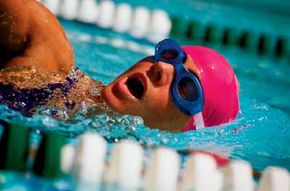Perhaps you were in the middle of your morning run or your evening aerobics class and it came on like gangbusters: shooting pain starting in the front of your ankle and continuing up almost to your kneecap. Now, when you touch the area on either side of your shinbone, it feels sore and tender. Could it be shin splints?
Although annoying, shin splints (and, indeed, most shin pain) is not an indication of a serious problem. It is an inflammation of the muscle or other tissue at the front of the lower leg that results from repeated, minor trauma or irritation, and it can be treated or prevented using the home remedies that follow. However, if your shin pain persists or recurs despite your self-treatment, see a doctor. You may be suffering from a stress fracture -- a tiny chip or crack in the bone. Stress fractures won't go away on their own and, without treatment, may become serious.
Advertisement
Don't work through the pain. You won't earn points in athlete's heaven for trying to tough out the pain of shin splints. At best, the pain won't lessen and at worst, you'll be setting the stage for a more serious injury. Stay off your feet, or at the very least, decrease your mileage while you're nursing a case of shin splints.
Ice it. Ice is the treatment of choice for reducing the inflammation of any sports injury, and shin splints is no exception. A handy method: Fill a foam or paper cup with water and stick it in the freezer. Once the water is frozen solid, peel back the lip of the cup to expose some ice, and massage the shin area for ten minutes at a time, up to four times a day for a week or two. You can also try icing the area with a bag of frozen vegetables, such as peas or corn kernels.
Tape it. Taping shin splints with an elastic bandage or wearing a neoprene sleeve that fits snugly over the lower leg may provide some comfort by compressing the area, which may help limit inflammation, and by supporting the tissues and permitting less muscle movement. (By the way, while it's wise to take it easy for at least a few days, you don't want to totally immobilize the leg; gentle movement helps bring nourishing blood to the damaged tissue while taking away excess fluid from inflammation.)
Take two aspirin. The over-the-counter analgesics aspirin and ibuprofen are usually quite effective in relieving the pain of shin splints, so you may want to give one of these a try. Either of them will also help diminish the associated swelling and inflammation. Acetaminophen, on the other hand, may ease the pain, but it won't help with inflammation. Women who are pregnant or nursing and anyone who has a sensitivity to any of these common medications should check with their physician before taking any medication. For a list of precautions to take when using over-the-counter analgesics, click here.
Tune in to your body. The biggest reason people get overuse injuries is that they don't pay attention to the signals their body gives them. If something hurts, rest it, ice it, and, if necessary, talk with your doctor about it to see what adjustments you can make to prevent the pain or injury from recurring.
Try an athletic insole. Since shin splints often arise as a result of the excessive pounding that occurs during jogging or other high-impact, weight-bearing activities, a padded insole placed inside the shoe may offer relief. These insoles help soften the blow as your foot lands on hard ground. You can purchase them at an athletic shoe store, sports supply store, and even some grocery and drug stores. They range in price from about $7 to $20. In addition, check to be sure the shoes you wear during the activity still have plenty of cushioning (see "Choosing an Athletic Shoe").
Stay off the cement. Another way to lower the impact of your routine is to be sure you exercise on forgiving surfaces such as a running track, crushed gravel, or grass. If you have to run on roads, try to choose streets paved in asphalt rather than concrete. If you do aerobics, you may need to stay away from cement floors, even carpeted ones. Suspended wood floors are best.
Cross train. One way to rest during an episode of shin splints without cutting out exercise altogether is to switch to another type of activity. If you're a runner, add some swimming, stationary cycling, or other activity that doesn't tax your shins as much as running.
Don't run on hills. Running up and down hills may contribute to or aggravate shin splints.
Prevent the injury from occurring in the first place. Always warm up before exercising to get blood flowing to the tissues. Warm muscles are less likely than cold muscles to be injured. Warm up with a few minutes of easy walking or gentle stretching.
Advertisement
